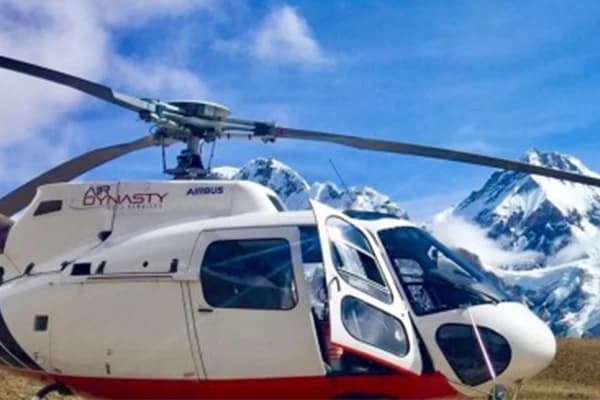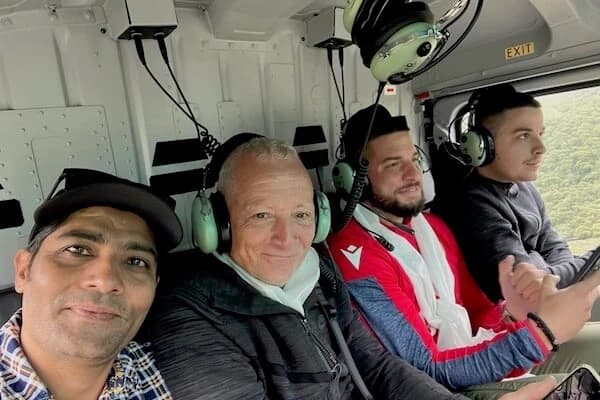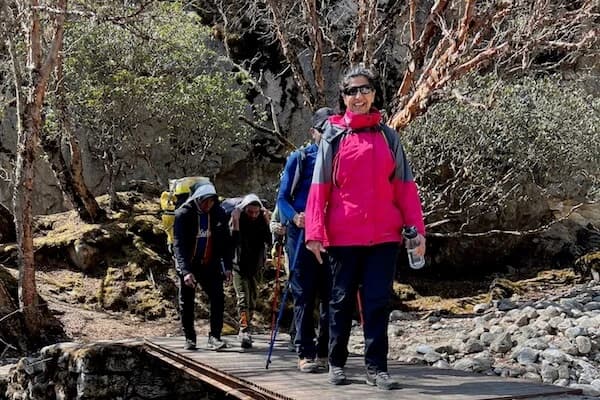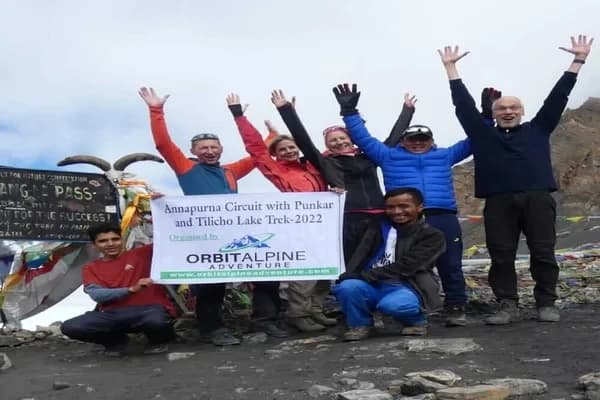The real difference is the challenge that this trek presents: high altitudes and steep slopes combined with long days of trekking demand top physical fitness, good mental strength, and proper adjustment. The trekker requires being ready for diverse weather conditions since the temperature can fall below zero during the night in some places and there is always a threat of altitude sickness as the trekkers have to cross normally over 5,000 meters most of the time.
Overview of the Everest Three High Passes Trek
The Mount Everest Three High Passes Trek is the journey trek of the Everest region, crossing three high passes: Kongma La Pass, 5,535 m / 18,159 ft; Cho La Pass, 5,420 m / 17,782 ft; and Renjo La Pass, 5,360 m / 17,585 ft. This trek will be a combination of Everest Base Camp, Gokyo Lake, and Kala Patthar, a real test for your dream.

The walk usually lasts 18-21 days depending on the itinerary and pace. It starts from and ends at Lukla. This small town hosts a popular airstrip that the general world refers to as one of the exciting runways that is both short and steeply inclined. Pass more Sherpa villages, forests,s and rhododendron trees via the Dudh Kosi River valley, to arrive at the trading center of Namche Bazaar, the unofficial capital of the Everest region.
Preparation and Training for the Trek
Preparation and training for the Everest Three High Passes Trek are quite immense. Trekkers must work on endurance, strength, and cardiovascular fitness. The best training to undergo is long hikes with a backpack, preferably on hilly terrain. This will allow them to practice carrying the weight they will have on them when they embark on the trek.
Strength training—specifically in the legs and core—will be useful when the route involves steep ascents and descents. This could be the most important factor, and hence trekkers should plan in their itinerary rest days at strategic places when their bodies regulate at the altitude. It should, however, be advised that the trek should not be at a fast pace but should be undertaken with steady footsteps to minimize the chance of being affected by altitude sickness. Equipment is the most essential thing needed for the trek.
The trekker should acquire good quality and well-fitting boots, warm clothing, and a strong backpack. For cold nights that will be experienced in high altitude, sleeping bags rated for cold temperatures, a down jacket, and layers of thermal clothing will be needed. Particularly across the passes, crampons and trekking poles can come in handy and be very useful.
Key Routes of the Trek and Challenges Faced
Compulsory Lukla to Namche Bazaar:
The trek starts with a flight from Lukla to Phakding and then lastly to Namche. One will be following the Dudh Koshi River, crossing it over and again through several suspension bridges. This climb from Phakding up to Namche is tough-moreover, the last stretch is steep and tiring, even for the unacclimatized person.
Acclimatization at Namche Bazaar needs at least one day of rest. A walk around the village with some height gain can be taken advantage of during this time. The village presents plenty of activities with shops, and restaurants besides being full of Sherpa culture.
Namche Bazaar to Tengboche:
This trail presents trekkers with a beautiful formation of Everest Lhotse and Ama Dablam. The trekking is said to be a moderately an easy trail with slight gains in altitude. The exceptional steep is extreme at the last part to reach Tengboche. The famous Tengboche Monastery, a spiritual center of the Sherpa community is located at Tengbo.
By Tengboche, the altitude starts to become more apparent and the trekkers may feel the thinner air. Acclimatization is key at this point as well as hydration.
Tengboche-Dingboche
The trek to Dingboche continues upward in elevation and for the most part, the scenery turns quite barren. The route to Dingboche takes over to the other side of the Imja Khola onto the villages of Pangboche and Shomare.

Still, another acclimatization stop is Dingboche. Trekkers tend to spend an extra day in this tiny village to acclimatize to the altitude. 4,410 meters 14,470 feet. A few well-known peaks overshadow the view, which includes Ama Dablam, Lhotse, and Island Peak.
Dingboche to Chhukung and Kongma La Pass:
The trek to Chhukung is easy and gradual but from here, you will expect the first major challenge -Kongma La Pass. The ascent to Kongma La is quite steep and serious, while from here, there is a long and tiring climb to the top of the pass. Views from the top of the pass are stunning with great panoramas of the surrounding peaks, while equally challenging however is the descent to Lobuche, needing careful navigation over loose rocks and scree.
Lobuche to Gorak Shep to Everest Base Camp
This trek from Lobuche to Gorak Shep is a bit plain, but the altitude makes it tiring. From Gorak Shep, there is a final push to Everest Base Camp. The way to Everest Base Camp is rugged and follows the Khumbu Glacier, with Everest in its soaring heights in the background.
Return to Gorak Shep and then an additional climb to Kala Patthar the next morning and the best viewpoint for Everest: The highest point reached on the trek is 5,550 m/18,208ft - Kala Pattha.
Cho La Pass to Gokyo:
The Cho La Pass is considered the most technically difficult of the three. The ascent of a glacier is thus steep hence calls for crampons crossing. The pass can also be icy and slippery. Its descent to Dragnag is equally not easy as it involves a rock trail descent to Gokyo valley.
The Gokyo Lakes and Gokyo Ri provide an all-around view of surrounding peaks and the Ngozumpa Glacier, the biggest glacier in the Himalayas. Gokyo Ri is also another harder climb, though its panoramas from the top are such that are rewarded by the effort
Renjo La Pass toward Thame and Namche Bazaar:
The final pass, Renjo La, was slightly easier than the other two but still a severe climb. The drop to Thame is long and weary. The view of Everest, Lhotse, and other peaks is spectacular. From Thame, retrace steps to Namche Bazaar where rest can be taken and repair work for the final cut to Lukla.
Contributing Factors to Trek Difficulty
Altitude
Exciting altitude is one of the major factors that adds to the difficulty of the Everest Three High Passes Trek. During this trek, one has to visit places that are above 5,000 meters more than once. The maximum height above sea level, where one would be walking during this trek, is that of Kala Patthar, which is situated 5,550 meters above sea level.
Since it is much thinner, it has much less oxygen at altitudes over 3,500 meters. This may well lead to altitude sickness: everything from slight symptoms like headache and nausea to critical life-threatening conditions like HAPE (High-Altitude Pulmonary Edema). It's not only saving trekkers from the illness of altitude sickness but also an opportunity to adapt to the geographical factor so that further trekking could be made.
The adjustment feature will be an important factor to avoid the hazard of altitude sickness. But this is written in the itinerary, with acclimatization days, so that the body receives the time it needs for recovery, with height increases in between destinations such as Namche Bazaar and Dingboche. Altitude sickness being a real threat, the trekker should be conscious of his health, walk slowly up, and drink a lot of fluids. The high altitude has made breathing difficult and, at the same time, mounted the physical demands of the trek due to extreme tiredness caused by poor oxygen levels in the air even for minor tasks.
Physical Fitness and Endurance
People like Everest Trek because it is physically demanding and requires a high level of fitness and endurance. This translates into a rather physically exhausting 160-200 km hike in distance, taking the hiker 6-8 hours daily to walk, with many of these hours on very steep and rough terrain. Treks on the three high passes-Kongma La, Cho La, and Renjo La-are also highly challenging in terms of physical requirements, both in terms of strength, stamina, and passion for mountain climbing since it involves very steep monsoon climbing.
The ascents to the passes
Both are frequently determined and tricky, each with its exclusive glitches: Kongma La-the highest of the three-is steep and rocky on high ascents and descents over loose scree. The Cho La is pretty icy and may require some sort of equipment, such as crampons, to make the crossing at the top of the glacier. Renjo La, while less steep, is still a long and fatiguing climb. With the high altitude added to these climbs, even the experienced trekkers are taken to their limits.
Preparation for the trek
Preparation for the trek should consist of cardiovascular training, strength training, and long hikes, preferably with a backpack, most importantly, so to build stamina and similarly prepare the body for the physical challenge, also one should be ready in mind to have physical exertion and, with the possibility of being fatigued this may be degraded by the altitude effects and bad weather conditions.

Weather Conditions
Weather likewise is another contributing significant factor to making the Everest Three High Passes Trek a greater challenge. The region of Everest experiences changing weather and, very often, is extremely changeable, sometimes creating drastic changes in its weather pattern. The trekkers should therefore be prepared for all circumstances starting from sunny or warm weather in lower altitudes increasing to being freezing cold, windy, and even snowy higher up.
The low temperature
Temperatures can be well below freezing, especially at night, and even during peak trekking seasons. Snowstorms can reduce visibility and make the passes themselves obscured by snow and ice, further complicating their crossing. Above all, great winds, especially on exposed ridges and the passes, may make trekking conditions very challenging indeed. A real threat of hypothermia in such conditions means that trekkers should never be without the right kind of cold weather gear, including thermal layers, a down jacket, waterproof clothing, and insulated gloves and hats.
Timing of the Trek
The timing of the trek is very important. The best times of the year to undertake the Everest Three High Passes Trek are pre-monsoon spring from March to May, and post-monsoon autumn from September to November. At that time, in general, the weather is more stable with clearer skies for better visibility of the mountains. However, even during these seasons, the trekkers must be prepared for sudden weather changes and even to face the cold, snow, and strong winds.
Remote and Rugged Terrain
The Everest Three High Passes Trek leads through some of the most remote and rugged terrain in the Himalayas. The paths are often steep, rocky, and uneven, requiring careful routing, most importantly when crossing the high passes. Long ascents and descents, narrow ridges, and loose screed that could make the footing rather treacherous are some of the challenging physical features.
The remoteness
The only factor adding more challenge to the journey is that facilities and conveniences gradually become rare as you ascend higher upwards. Teahouses, which become your dominant type of accommodation, become much, much more basic the higher up you go with no facilities like electricity, hot showers, and sometimes even water. Very crowded teahouses in certain areas and during busy times might sometimes also lead to shared rooms and sleeping in common areas.
In case of emergencies
Once out trekking in this remote location of the trek, options are very limited for evacuation; by helicopter at a premium is one such means available, that is, of course, the proverbial "if the weather is good". Thus, the trekkers must carry with them a complete first-aid kit and be able to look after injuries or sickness by themselves. It is, hence, very important that one has adequate travel insurance that covers high-altitude trekking and emergency evacuation.
Mental Toughness
The Everest Three High Passes Trek is as much a mental challenge as it is physically. High altitude, long days of walking, severe conditions, and a remote, rough corridor of the trek bring out the real meaning of the mental strength to handle this trek. Prepare your mind for dealing with tough situations arising due to the trek-weariness, discomfort, and feeling isolated.
Development of mental flexibility
It is what is key to overcoming the challenges of the trek. The long days of walking many times in bad conditions may irritate you mentally. Be motivated and positive about reaching your goal. Mentally prepare yourself for the possibility of probably turning back due to altitude sickness, injury, or bad weather. With all its challenges, cultural immersion is a very good eye-opener to the individual. It encompasses the right mind to make appropriate decisions, from knowing when to push and when a halt needs to be.
The interaction with other trekkers will also keep the morale so much needed. The Sherpa culture of the Everest region warms one to face the challenges, and the people are so hospitable. Interacting with the rest of the trekkers, sharing stories, and supporting one another through hard moments make this journey bearable and even more enjoyable.
Conclusion
Everest Three High Passes Trek is adventurous and challenging, one of the more rigorous treks in the Himalayas, demanding a high level of physical exertion, and with a good level of stamina and due preparation put together with hardiness. But for the ready, the rewards are awesome. It is one of the most fantastic mountain sceneries in the world, drenched with Sherpa people's culture, and attains a certain feel that is not equaled by many treks. It's truly a trip that will push the bounds of trekkers, lifetime experiences, and memories never to fade.
Frequently Asked Questions
1. What is the Everest Three High Passes Trek?
The Everest Three High Passes Trek is one of the challenging trek routes going to the Everest Region of Nepal. Major Mountain Passes included on this trekking route are Kongma La Pass 5,535 meters/18,159 feet, Cho La Pass 5,420 meters/17,782 feet, and Renjo La Pass 5,360 meters/17,585 feet, including Side trips to Everest Base Camp, Gokyo Lakes, and Kala Patthar.
2. How difficult is the Everest Three High Passes Trek?
The trek is hence considered one of the most difficult in the Everest region, majorly due to high altitude, long days of trekking, and a difficult terrain profile. Trekkers have to be in fine fettle and toughened mentally to face such abuse/conditions that a trek has to offer with high altitude bringing symptoms of altitude sickness and harsh weather, which remains mainly rough on higher grounds.
3. How many days does the trek last?
The trek generally goes on for about 18 to 21 days at the most based on the trek's itinerary and pacing.
4. When is the best time to go for the Everest Three High Passes Trek?
Pre-monsoon. This season generally has stable weather and beckoning clear blue skies with the great visibility of peaks. Somewhat chilly by night at higher elevations.
5. Do I need to have prior experience in trekking to do the Everest Three High Passes Trek?
It is recommended that you have prior trekking experience since it is not an easy trek. The trek is preferred for people having experience in multi-day hiking, especially at high altitudes. The experience with crampons and trekking poles comes in handy when crossing the passes.
6. What is the type of accommodation on the trek?
The rooms available are teahouses, the basic lodges offering a bed and meals, which sometimes even include hot showers and often Wi-Fi. The standards of teahouses vary from good to bad and get very primitive at the highest altitudes. Overnight temperatures drop dramatically, so it is recommended to bring a good-quality sleeping bag.
7. How many permits will be needed for the Everest Three High Passes Trek?
Two permits are needed for trekkers. One is the permit for Sagarmatha National Park Entry and another is for Khumbu Pasang Lhamu Rural Municipality. It can be issued in Kathmandu or at the entry point of the trek. Normally if you are trekking through a guide or trekking agency, they do the permit arrangement.
8. Do I need a guide for the Everest Three High Passes Trek?
This trek is quite independent in style, but the toughness of the trek recommends hiring a guide. Local insight, especially while crossing the passes, might help, as will one of those unplanned emergencies that life might hit you with. Having a guide helps get cultural insights—the one thing that always enhances the experience overall.
9. What to pack for the Everest Three High Passes Trek before leaving?
The materials needed for the Everest Three High Passes trek will be prepared for bad conditions. However, their packing lists may include but are not limited to good-quality backpacks, trekking boots, warm sleeping bags, down and prefabricated jackets, thermal layers, waterproof jacket and pants, gloves, hats, sunglasses, sunscreen, headlamps, the first-aid kit, trekking poles, and many others. You might also have to carry along crampons for the crossing of the passes, especially for Cho La. It would be overkill to avoid carrying sufficient gear, so avoid being overloaded; in any event, this is of great importance in keeping oneself dry and warm.









